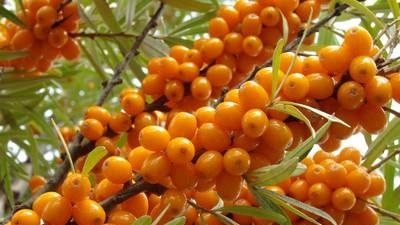|
 From the Latin language, buckthorn (buckthorn) literally translates as "shiny horse". The ancient Romans gave this name to the branchy shrub growing on the sands and pebbles along the river banks, for a reason. They noticed that if horses are regularly fed with sea buckthorn leaves or fruits, the horses' coat becomes shiny and shiny. From the Latin language, buckthorn (buckthorn) literally translates as "shiny horse". The ancient Romans gave this name to the branchy shrub growing on the sands and pebbles along the river banks, for a reason. They noticed that if horses are regularly fed with sea buckthorn leaves or fruits, the horses' coat becomes shiny and shiny.
Sea buckthorn blooms in May. The fruits ripen in autumn and remain on the branches all winter. The berry is round and orange in color. The juicy pulp contains a dark brown pit inside. The sea buckthorn tastes somewhat bitter. But with the first frost, the bitterness disappears. The taste of the berry becomes sour-sweet.
The plant is rich in bioactive substances. This is first of all vitamins B contained in fruits. They are also rich in carotene, organic acids, tannins, trace elements of iron, magnesium, boron, silicon. The leaves are a storehouse of vitamin C. The branches and bark contain tannins.
The healing properties of sea buckthorn have been known since ancient times. A decoction of berries has always served as an excellent remedy in the treatment of skin diseases, various rashes, non-healing ulcers. It was also used for rheumatism, and the seeds were used as a laxative. Nowadays, such a valuable medicinal product as sea buckthorn oil is prepared from sea buckthorn. You can also get it at home. For this, squeezed natural juice is defended in a cold place and the floating oil is removed.
 Fruit pulp and seed oil is rich in vitamin E, carotene, fatty acids, which are involved in the metabolism of the skin. For prophylactic purposes, the oil is used internally and externally as an analgesic and wound-healing agent. In gynecology, it helps with cervical erosion, endocervicitis, colpitis. Fruit pulp and seed oil is rich in vitamin E, carotene, fatty acids, which are involved in the metabolism of the skin. For prophylactic purposes, the oil is used internally and externally as an analgesic and wound-healing agent. In gynecology, it helps with cervical erosion, endocervicitis, colpitis.
For eczema, lupus ulcer, scaly lichen, sea buckthorn oil is prescribed orally 1 ml per day or externally in the form of an ointment. At the same time, erythema decreases, edema decreases, pain and burning are relieved, and peeling stops. There is also a good effect in the treatment of burns, but without much benefit over other treatments.
In the complex treatment of peptic ulcer disease, sea buckthorn oil is used for 3-4 weeks at a dosage of 1 teaspoon 3 times a day. At first, this can cause heartburn and sour belching due to the presence of a large amount in sea buckthorn. free fatty acids... Burned magnesia or 2% baking soda solution neutralize discomfort. Soda is usually added directly to sea buckthorn oil, and shaken well before use.
The healing properties of sea buckthorn also extend to sinusitis, hypertrophic pharyngitis and aphonic laryngitis. In addition, sea buckthorn oil is used to treat frostbite, bedsores, and phlegmon. In ophthalmology and oncology, the healing properties of sea buckthorn are used as a prophylactic agent against the development of atrophic tissue changes during radiation exposure. In addition to sea buckthorn oil, other parts of the plant are used in medical practice, however, to a much lesser extent.
Shakin P.A.
|